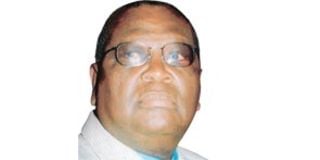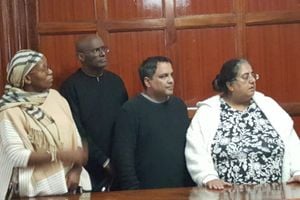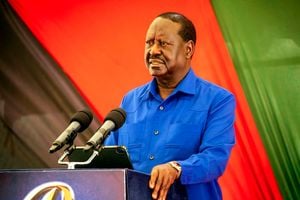Exposed: Spymaster plan for Uhuru, Raila

The late Mr James Kanyotu, who was at the helm of the Intelligence services for 27 years.
Raila Odinga was to become prime minister in 2002, under a Uhuru Kenyatta administration, according to a Moi succession plan put in place by a former Intelligence chief, the Sunday Nation has learnt.
Picking Uhuru Kenyatta to succeed Mr Moi was the former spy chief’s idea, the sources claimed.

The late Mr James Kanyotu, who was at the helm of the Intelligence services for 27 years. Photo/FILE
Mr James Kanyotu had been secretly tasked by retired President Moi in 1994, to work out a smooth succession plan for the former Head of State, according to people privy to power politics at the time.
Wide ranging interviews with this correspondent revealed the extent to which Mr Kanyotu and the intelligence services shaped the history of Kenya — most times for good, sometimes in the wrong direction.
They reveal the complex life of a man who went to great lengths to serve and protect his country.
For that cause he betrayed friends and foreign countries with equal ease, took big risks, broke the law but at all times kept his mouth shut.
Early January six years ago, a four-man committee burning the midnight oil at the Serena Hotel, had resolved that the position of prime-minister be created for Mr Raila Odinga, then a Cabinet minister in then ruling Kanu/National Development Party of Kenya (NDP) coalition.
However, the idea was shot down by hard-liners in the dominant coalition partner, Kanu, according to a former Intelligence source, who had access to the committee’s deliberations.
Giving Mr Odinga the premiership, according to the source, was to be the culmination of a carefully choreographed Moi succession plan, crafted behind the scenes by, among others, James Kanyotu, the long serving head of Kenya’s Intelligence.
Separately, Mr Odinga’s brigade in the Kanu/NDP coalition was also asking for the same thing, unaware that their Kanu counterparts were sitting on a similar proposal by the late spy chief.
Retired President Moi sacked Mr Kanyotu as Kenya’s spymaster after 27 years of service in December 1991, only to quietly bring him back three years later with a request to help him work out his succession plan, according to the source.
The Kanyotu blue-print was that Uhuru Kenyatta take over from Mr Moi as president at the expiry of his term in December 2002 with Mr Odinga as his prime minister, the source revealed.
Mr Kanyotu died on February 13 this year and just two weeks before his prime minister plan was resurrected - this time by different players and under different circumstances altogether.
On February 28, President Kibaki and Mr Odinga signed the deal that eventually saw the latter sworn in as prime minister last month.
Mr Kanyotu, were he alive today, would mentioned, let alone credited, for having been first with the formula that he thought would give Kenya a more stable political dispensation in the post-Moi era.
Secrecy was a creed and a way of life for him.
Even news of his death filtered out the same way he toiled and bowed out.
Messages of condolences upon his death too, would be couched in a cryptic language – perhaps the most fitting tribute to the man who spent his adult life in the dark caverns of espionage.
Twelve hours after he was pronounced dead from a cardiac arrest at the Nairobi Hospital, even his closest friends were telephoning whoever they thought could confirm the “rumour” that Mr Kanyotu was dead.
The Press would not know about the death until 15 hours later. And when a family spokesperson finally came out to confirm the news, it was just a vague one-liner.
He had told the media: “There is some truth in what you are talking about but find out the details for yourself.”
The secretive world Mr Kanyotu lived was only hinted at by those who have more than just a clue.
At his burial in Kirinyaga district on February 21, President Kibaki described him as “one who knew so much about what he knew and did what he thought should be done.”
Earlier, retired president Moi had mourned the man who was his top spy for the first 13 years of his administration as a man of immense knowledge and great powers “but who was guarded not to show it”.
A more curious message came from another man who at one time worked very closely with Mr Kanyotu, former powerful Attorney-General, Charles Njonjo.
Speaking at Mr Kanyotu’s memorial service at the All-Saints cathedral a day before he was laid to rest, Njonjo repeatedly said his dead friend “could never have hurt a fly”.
Outside the church, a retired top civil servant and close confidant of the late spy chief remarked to this writer only in half jest: “Of course Njonjo is right. Why would Kanyotu have hurt flies when he was killing elephants?”
Born in 1936, Mr Kanyotu joined the police force as a direct-entry inspector at the age of 24, after only three months working first as a school-teacher and then a journalist.
He had attended Alliance High School and attained a diploma in teaching at Makerere university.
In January 1965, he was named the country’s second head of Intelligence, a position he held for the next 27 years, earning himself the nick-name J. Edgar Hoover of Kenya, a comparison to the long-serving head of US Federal Bureau of Investigations (FBI).
He had taken over from Bernard Hinga who doubled up as independent Kenya’s first African Intelligence head and later police commissioner.
It is a testimony to Mr Kanyotu mastery of his job that three years after his controversial exit in December 1991, retired president Moi informally recalled him to help steer his succession plan behind the scenes.
Unknown too, is that up to the time of his death, he was an occasional and valued guest at Mr Kibaki’s State House.
Owing to his privileged position as the country’s longest serving top spook, his finger-prints are to be found in all major events that have shaped independent Kenya’s history, for better and for worse.
Highlights:
- When rebels from the Kenya Air Force attempted to seize the government in August 1982, Mr Kanyotu stayed awake for 72 hours to make sure it never happened.
- Eleven years earlier in 1971, his secret liaison with then Uganda’s armed forces chief of staff Gen Idi Amin – later to become president – saved Kenya from a military coup.
- At the climax of the fight for return to a multi-party system in 1990/91 period, Mr Kanyotu played the delicate game of running with the hare and hunting with the hounds.
- When the government decided to detain key leaders of the multi-party campaign ahead of the Saba Saba riots of July 1990, he leaked the news to Paul Muite, then lawyer and key strategist to politicians Kenneth Matiba and Charles Rubia, and advised him to go underground.
- A few days later, the spy chief made arrangements for the latter to “surface” in the newsrooms and later at State House briefed the President on the need to constructively engage the growing opposition. Mr Kanyotu had correctly read the signs and knew the wind of change was unstoppable hence the need for the country’s leadership to embrace it and manage it to its benefit rather than wait to be swept aside.
Mr Muite, however, has a different version of events. He says that in 1990, he visited then President Moi at State House through an arrangement made by former high ranking official Walter Kilele, whom he had represented in civil matters in court.
“Kanyotu had nothing to do with it,” Mr Muite told the Sunday Nation Saturday.
The immediate former MP for Kikuyu, however, recalls an earlier incident in 1986 when his lawyer friend Gibson Kamau Kuria was detained.
At the time, Mr Muite was to represent Dr Kuria in court and ask that he be formally detained to avoid torture at the hands of Special Branch men.
The Special Branch officers decided that they would arrest Mr Muite, too, because they had heard him tell Dr Kuria not to allow the torture “to break you.”
I was referring to Ngugi wa Thiong’o’s Detained in which he advised anyone who might go into detention not to let the officers break their spirit even though they could break the body.
After Dr Kuria was arrested, a friend of Mr Muite’s who he did not wish to name tipped him off that he was next.
“I went to (Charles) Njonjo’s house because I knew that he and Jeremiah Kiereini were friends of Kanyotu and asked him to find out the true position,” Mr Muite said.
(Njonjo in turn went to Kiereini the following morning who, in turn, went to see Kanyotu about it. Later that day, Kiereini and Kanyotu went to see Moi who was startled that I even knew what was going on.”
Mr Muite says that he came to learn that, at the State House meeting, President Moi decided to drop the plans to have him detained over worries that the Americans had taken a very keen interest and international pressure was high on the government over the growing list of political detainees.
Mr Kanyotu will be remembered as the mysterious hand in the Goldenberg scandal. He and Kamlesh Pattni were co-founders of the company associated with the biggest heist of tax-payers’ money.




